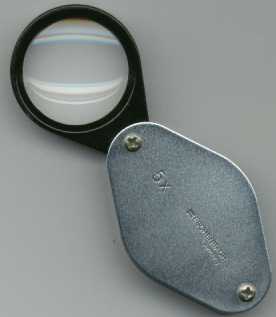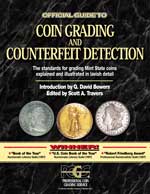 5x
Eschenbach loupe
5x
Eschenbach loupeBy Michael S. Swoveland
The topic of grading is one that is sure to evoke controversy anywhere two or more collectors are gathered. However, it has not always been so. In the 1800s coins were graded "new" or "used," prior to that they were often not graded at all. By about 1900 the need for additional terms to describe the condition of coin was seen and the grades "good" and "fine" were added to the numismatic lexicon. In 1958 William Sheldon introduced his 70 point grading system for Large Cents. By the 1970s, the ANA had adopted the Sheldon system as the standard for all United States coins. With the introduction of PCGS and NGC in 1986, our modern grading system took shape. In this brief article, I will attempt to offer suggestions on grading technique rather than to teach you how to grade, which is beyond the scope of this article.
A wise coin dealer once told me to "withhold your admiration for the coins you own." There is a great deal of wisdom in his statement. When you are looking at a coin that you considering for a purchase, you should have a critical eye. Look first for the reasons you should NOT buy the coin. Does it appear to have been cleaned? Are there rim bumps? Do you see hairlines in the fields. Does the toning look original? All of these are questions you should ask as you examine a prospective addition to your collection. I will usually begin with the rim at 12:00 and work my way around the coin in a clockwise direction, I then repeat the process with the outer 50% of the coin and again with the inner 50%. Whatever method you use, be consistent, use it with every coin you look at. Be sure you do this with both sides, you don't want any surprises when you get the coin home! Is the lighting adequate for the examination? Florescent light or low light may cause you to miss something. You should also be aware of the background as a red background will tend to distract the eye. If magnification is required a 5x to 7x glass is all that is needed, but an examination with the naked eye should be done first. Your first impression will generally not change after looking at the coin under magnification.
In general it is best to grade in a room with controlled lighting. In my opinion a room without windows is best as this avoids the variations in light source caused by the suns relative position in relation to the window. However, in the real world this is usually not possible. Because there is a large window about 4 feet away from the desk in the office where I do much of my coin related work, I prefer to do most of my grading after dark. I have found that the best light source is a 100-watt incandescent bulb about 3-4 feet from the coin. While incandescent light is generally best, the human eye is very versatile and can adjust to most lighting conditions. Consistency in lighting is more important than the type of lighting.
Most coins can be graded without using a magnifying glass, however there are times when a glass will be needed, or desired, if only to confirm your initial opinion. In these cases most graders use a 5x or 7x loupe. It is not necessary to spend a great deal of money on your loupe, often a $10 glass will be all you need. If you desire a loupe that will last a lifetime however, Bausch & Lomb or Eschenbach are good choices, but expect to pay $60-80 for a good glass. I use a 5x Eschenbach which due to it's precision ground glass does not have any distortion even at the edge of the field of view.
 5x
Eschenbach loupe
5x
Eschenbach loupe
1. WEAR - This is perhaps the most obvious point to consider. Does the coin show wear and if so to what degree. Knowing where to look on a particular type of coin is essential. If for example you do not know that the hipbone on the reverse of the Buffalo nickel is the first point to show wear, you run the risk of bringing home an AU-58 thinking it is MS-64 (and loosing some money in the process).
2. STRIKE - On Mint State coins strike is an important factor as a weakly struck coin cannot be considered a Gem. Knowing what a fully struck coin of the type you are considering looks like is a critical factor in determining it's grade.
3. MARKS - Bag marks, scratches rolling marks etc., all have an impact on the grade of a coin that cannot be understated. Knowing what to look for and the key areas to look at is important.
4. LUSTER - Luster is also a factor in determining the grade of a Mint State coin. Is it blazing luster that makes the surface of the coin look almost liquid, or is it subdued?
5. TONING & EYE APPEAL - These areas are more subjective than the others we have looked at, but they do play a part. Knowing what is generally considered attractive will benefit you in building your collection. If you are buying BU Morgan dollars that are toned dark gray or have splotchy toning, do not expect the same returns as the collector who seeks out attractive toning or brilliant (white) coins.
The best way to learn to grade is to look at coins, lots of coins. I recommend examining coins that have been certified by one of the three major grading services (PCGS, NGC or ANACS). Talk to coin dealers or experienced collectors. Don't be afraid to ask questions, most dealers and collectors are happy to help. There are also several books available that will teach you the basics. I recommend "Official ANA Grading Standards for United States Coins." This is an excellent guide for circulated coins as it has a photo of each coin type in each grade. You basically just match your coin to the picture.
 PCGS Coin Grading & Counterfeit Detection
PCGS Coin Grading & Counterfeit Detection
I also highly recommend "Coin Grading and Counterfeit Detection" which is published by PCGS. This large format book has hundreds of high quality photos and is superbly written. In my opinion this is the best book available on the subject of grading. Until you feel comfortable with your grading skills, the best advice is to only buy from dealers you trust, or if you plan on spending a lot of money on a certain coin buy one that has been certified by a major grading service.
2002 AETHELRED.NET. All rights reserved.